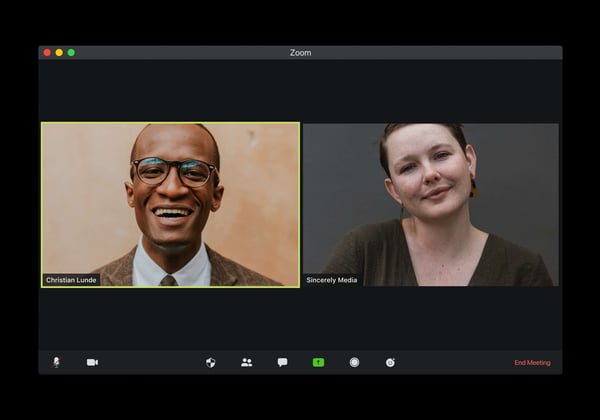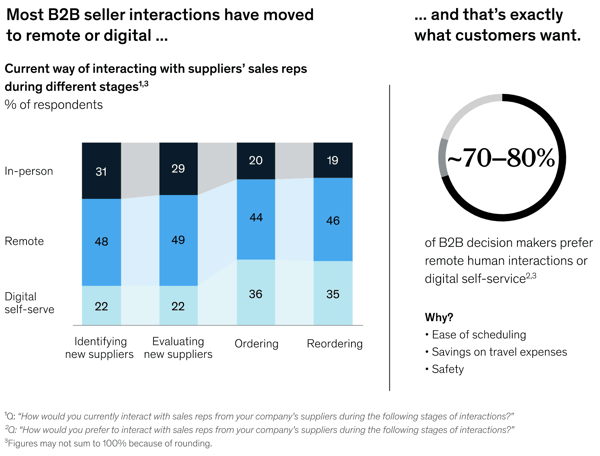Share this
Is virtual selling worth it?
by RepSpark Team on December 1, 2020
Over the past few years, there has been a slow adaptation to digital selling.
In 2020, brands, buyers, and trade shows went remote with Virtual Trade Shows and Virtual Showrooms to continue operating amidst the pandemic. While having a B2B selling technology is a necessary asset for doing business in our new normal, there is still the lingering question - "Are Virtual Showrooms and Trade Shows worth it?
While there are many mixed responses to the virtual environment, it's safe to say that adjusting to any change will take time. Virtual selling was a significant disruption in an industry operating in a face-to-face environment for over 50+ years, so no surprise that any shift can cause shaking.

What is Virtual Selling?
First, let’s define what virtual selling is because it’s relatively easy to get confused. Virtual selling is when a salesperson sells remotely instead of face-to-face or in the office.
To sell virtually, many companies are using video conferencing tools, like Zoom or Google Hangouts, to conduct business that was traditionally done in person. In addition to the video conferencing tools, a B2B sell platform is necessary for buyers to interact with products and for sellers to have a platform to sell the products. Combining these two elements creates an efficient virtual selling process.
Is Virtual Selling Worth it?
From a Brand's Perspective
Brands have experienced the most rattling and mixed emotions around virtual selling. And rightly so, as they are developing the digital selling content while also establishing the season's new assortment. Based on a survey done from Tradeshow Logic, the four following factors were common challenges faced by vendors were:
- Not enough time to adequately prepare
- The challenge of learning multiple virtual event technologies
- Lack of networking participation in the exhibit hall and minimal engagement with attendees
- Discovering new ways to convey the value of their products and services
From a Buyer's Perspective
Let's switch sides and look at the buyer's perspective. McKinsey's recent survey on how COVID-19 has changed B2B buying, ~70-80% of buyers prefer the digital experience. Buyers found it easier to schedule appointments, it cut back on their travel expenses, and most importantly, it protected their safety. The following graph is taken from the McKinsey report.

From a Trade Show Perspective
While we are unsure when face-to-face meetings will return, Apparel News interviewed the Directors of several different tradeshows to get their feedback. The overall feedback was that while Virtual Trade Shows were implemented, the face-to-face experience was greatly missed. In the future, and if face-to-face events can resume, many expect to combine both the in-person and digital experience for their shows. On the positive side, more buyers could attend the event, and the ability to book appointments with vendors was spread out for months instead of a few short days. However, the overall inability to network with new buyers, touch the products, or see it draped on models was missed.
Summary
As you read, there are many mixed results, but the customer is always right at the end of the day. We must continue operating our businesses and keeping everyone safe, then ways to adapt to virtual selling should be the better focus.
As a brand, what were the challenges you faced with virtual selling in 2020? Did the four challenges from Tradeshow Logic resonate with your experience?
If so, here are a few solutions to guide you and help you be successful for the next round in 2021.
- Invest in a B2B selling platform that will fit into any trade show technology. It will make tradeshow experience efficient for your brand and help alleviate the pain of learning new systems for each show. RepSpark is formatted to meet all tradeshow systems.
- Get your digital assets ready to shine in 2021. Invest in the right video equipment, photographers, and videography to capture your products. [LINK]
- Hire a designated representative to work the exhibit halls to capture leads.
- Leverage online influencers and online advertising to connect with buyers before the show begins.
- Make notes and invest in a good videographer or a photographer to evoke your products' touch and feel.
If you would like to learn more about RepSpark and to invest in a B2B software that will grow with your brand, then Schedule a Demo today. We are not a one-size-fits-all solution; instead, we craft custom software specifically designed to grow with your business goals.
Share this
- March 2025 (11)
- February 2025 (11)
- January 2025 (11)
- December 2024 (11)
- November 2024 (13)
- October 2024 (12)
- September 2024 (6)
- August 2024 (9)
- July 2024 (7)
- June 2024 (8)
- May 2024 (7)
- April 2024 (1)
- March 2024 (3)
- February 2024 (1)
- January 2024 (6)
- December 2023 (1)
- November 2023 (2)
- October 2023 (2)
- September 2023 (2)
- August 2023 (10)
- July 2023 (3)
- June 2023 (4)
- May 2023 (4)
- April 2023 (7)
- March 2023 (4)
- February 2023 (2)
- November 2022 (1)
- October 2022 (2)
- September 2022 (1)
- August 2022 (2)
- July 2022 (2)
- May 2022 (1)
- January 2022 (2)
- November 2021 (1)
- October 2021 (5)
- September 2021 (1)
- July 2021 (2)
- June 2021 (1)
- March 2021 (4)
- February 2021 (3)
- January 2021 (2)
- December 2020 (4)
- November 2020 (1)
- October 2020 (1)
- September 2020 (1)
- August 2020 (2)
- July 2020 (2)
- May 2020 (1)
- April 2020 (3)
- March 2020 (1)
- February 2020 (1)
- January 2020 (2)
- December 2019 (3)
- November 2019 (1)
- October 2019 (5)
- September 2019 (2)
- August 2019 (2)
- July 2019 (5)
- June 2019 (1)
- September 2018 (2)
- February 2018 (2)
- January 2018 (2)
- November 2017 (2)
- October 2017 (2)
- August 2017 (1)
- June 2017 (3)
- May 2017 (3)
- April 2017 (1)
- March 2017 (1)
- February 2017 (1)
- January 2017 (2)
- October 2016 (1)
- September 2016 (1)
- August 2016 (4)
- June 2016 (2)
- May 2016 (1)
- April 2016 (3)
- March 2016 (2)
- February 2016 (3)
- June 2015 (1)
- November 2014 (1)
- August 2014 (2)
- July 2014 (1)
- May 2014 (1)
- January 2014 (1)
- December 2013 (1)
- June 2013 (1)
- May 2013 (1)

